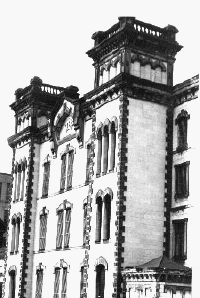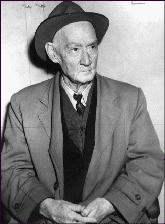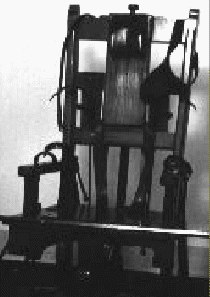MAN EXECUTED AFTER 1907 SIDNEY,
OHIO MURDER |
Our thoughts turn once again
this week to issues of crime, punishment and the rights of the accused as another murder
case winds its way through our court system. These topics and others were hotly debated
almost ninety years ago in what was perhaps Sidney's most notorious murder case. This is
the story.
An eerie silence descended over the thirty spectators as
the death mask was slipped over his face. His head had been previously shaved in what the
inmates referred to as the 'toilet of death.' The Sidney Daily News reporter who
was present described the scene: "Frank Earl complained against his wretched
fate... Within thirty seconds of eternity he protested he had not slain William Legg at
Sidney... This denial formed a dramatic incident in the gloomy theater of horror." It was 12:06 am on December 20, 1907. As the first contact was made, 1,750 volts surged
through Earl's body. The spectators looked away. Who was this man, and what events led to
this macabre end?
William B. Legg and his wife had operated a small meat market at what is now 528 W.
Michigan St. in Sidney for about eight years after having moved here from Indiana. There
was certainly nothing unusual about Saturday, April 20, 1907, at the market. Mrs. Legg had
retired to the living quarters in the same structure earlier that evening. Garney
Woodruff, Legg's clerk, left around 10 p.m. At about 10:13, two men entered the store,
guns drawn, and demanded money. Legg kicked at one of the robbers, and two shots rang out
in quick succession.
|

Ohio
Penitentiary
|
| The assailants ran from the store. Two
witnesses heard the report of the guns, and saw two men run north into the shadows on
Linden Street. In the doorway lay the lifeless body of William B. Legg. All three
newspapers in Sidney carried the story. The Daily News expressed the sentiments of
an outraged public: "The shooting of Mr. Legg was a cold blooded, premeditated
murder and one of the most atrocious crimes ever committed in the history of Shelby
County." If the guilty parties were ever caught, the word on the street was that
'justice' would be carried out before they could ever make it to trial.
Police Chief O'Leary deduced the men had fled the
city. He gave the only description the witnesses could give (one tall man with a stiff hat
and one short man with a 'slouch' hat, both dressed in dark clothing) to the conductors of
every train passing through Sidney.
Detective Dan Kelley of the Lima police department was walking his beat the next Sunday
morning around the square in Lima when he observed two strangers generally matching the
descriptions received from Chief O'Leary. Both men drew their guns, but Kelley knocked one
down and subdued them both. The citizens of both Lima and Sidney would later establish a
'Hero's Fund' for Dan Kelley, and present him with a substantial check. Word traveled like
wildfire back to Sidney. The murderers were caught. O'Leary hopped the next train to Lima.
He and Kelley confronted Frank Earl and Frank Walker for the first time. There was no talk
about providing an attorney. They were separated, and questioned throughout the day and
into the night. |

Chief O'Leary
|
As the Daily News would later describe
it, "the sweating process began." The suspects were stripped of their
clothes, and the questioning continued. Eventually, Walker broke, and implicated Earl as
the one who had fired both shots. Chief O'Leary was credited with obtaining the
confession. Sidney witnesses brought to Lima said they identified the men. The case seemed
open and shut.
Hundreds of men, seething with hostility, gathered at the downtown
traction line depot in Sidney for the return of the culprits. O'Leary slipped them off at
an earlier stop, walked them around south of the jail and in through a side entrance,
giving them cells on separate floors. He installed a 24 hour guard for each. Within a
week, the talk of lynching subsided.
By April 26th, a special grand jury was drawn, and it quickly returned an indictment
against both men. Each edition of the local papers carried not only the facts, but every
possible rumor and speculation about both the crime and the defendants. Both Earl and
Walker were hobos, who traveled from town to town by catching freight trains. Both used
aliases frequently, and each had prior criminal records.
Frank Earl's prior criminal record was exhaustively detailed in the tabloids. The Daily
News blared: "Earl Proves to be Ed Dalton, a Noted Crook." Within a
few days, prison records were received from Illinois. While incarcerated there several
years ago, Earl tried to avoid a work crew by letting two of his fingers get caught in a
machine. His entire arm was pulled in, and shredded up to the elbow. The local papers now
carried every lurid detail.
Judge Mathers determined that the cases were going to trial quickly. Several local
defense attorneys, including J. D. Barnes, were asked by Judge Mathers, but declined to
represent either defendant. Eventually, Judge Mathers appointed Percy R. Taylor and Hugh
R. Doorley to represent Earl. Charles Hall agreed to handle Walker's case. At the
arraignment on May 6th, a trial date for Frank Earl was set for June 14th. Walker was
slated to face a jury a week later.
Meanwhile, the legal maneuvering began behind the scenes. Walker agrees to testify for
the state against Earl. After agreeing to the deal, prosecuting attorney Charles Marshall
and his co-counsel J. D. Barnes began to have doubts about Walker's story. Several doctors
were dispatched to reexamine Legg's remains. A second bullet was found in the body- and it
came from a 32 caliber gun, the kind found on Walker when he was arrested. Walker had lied
in his confession. Suddenly, the case was not quite as open and shut as it had seemed at
first .
On May 25th, Earl's attorneys filed motions to change the venue, or location, of the
trial, and to postpone the trial. The motions were heard the next Saturday morning, and
immediately overruled. Inexplicably, only one affidavit and no newspaper articles were
submitted in support of the motion to move the trial to another county, despite the
continuous and inflammatory publicity. For example, the Daily News opined in its
April 22nd edition: "The guilty parties have been captured and all that is left to
do now is to speedily punish them. A quick trial is demanded and must be had
immediately."
It must have been a very nervous Frank Earl
who stood trial for his life in the common pleas courtroom on June 14, 1907, in front of
several hundred spectators. The state's case was presented quickly. The state, as his
counsel P. R. Taylor argued, had built its entire case on the story of Frank Walker. That,
however, would be enough. After selecting a foreman, the jury reached a guilty verdict in
thirty minutes. After another hour of deliberation, they voted eleven to one against a
recommendation for mercy. The sentence pronounced by Judge Mathers was what those who
crowded into the courtroom had come to hear: "death by electrocution." Frank Earl was scheduled to die November 29, 1907.
Half way through Earl's trial, the
Daily News announced that Frank Walker was actually Frank Whiting, the son of a prominent
Illinois doctor. Members of his family, including his father, and a Baptist minister
brother, rushed to Sidney to aid in brother Frank's defense. Walker's deal was sealed
within a few days. He pled guilty to second degree murder, and was given life in prison.
Meanwhile, immediate efforts were commenced to save Earl's life. P. R. Taylor filed a
motion for a new trial the day after the verdict against his client. The motion set forth
ten grounds, or reasons, that Earl should receive a new trial. Among the allegations was
the charge that J. D. Barnes erred by arguing to the jury that the defendant's guilt could
be implied because the defendant did not testify.
The most serious allegation was one of jury misconduct. Sidney resident Mrs. Frank Fogt
submitted an affidavit quoting one of the jurors, S. D. Young, as saying before the trial: "If I am a juror in that case (meaning Earl) I would never leave the jury
box until he (Earl) was convicted." During jury selection, Young had
denied he had formed an opinion as to Earl's guilt. Judge Mathers overruled each ground of
the motion for a new trial on July 6th.
During the subsequent months, members of Earl's team of defense lawyers worked to save
his life. They produced a number of affidavits establishing an alibi for Earl on the night
of April 20th. Walker even signed an affidavit, stating Earl was not with him at the scene
of the crime (which he later recanted). In rapid fashion, they ran out of options. The
Circuit Court of Appeals affirmed the verdict, and the Ohio Supreme Court declined to hear
the case. It was now late November, 1907.
The day before he was to be executed, the Daily News carried the story that Earl
was given a reprieve until December 20th to file his appeal with the Ohio Board of
Pardons. The Board met late into the night of December 5th, examining the affidavits and
hearing the evidence. Earl was encouraged. With the rays of the next day's morning sun
came the bad news: his appeal had been turned down. The drafter of the alibi affidavits
had used the language 'on or about' to describe the date of Earl's presence in another
city. The Board commented that if the affidavits had just been more specific...
| An appeal to Governor Harris by Earl's two
sobbing brothers for a delay in his execution or a commutation of the death sentence to
life in prison was rejected. The end was near. On the night of the 19th, he embraced
religion. Thirty spectators gathered at the Ohio Penitentiary on December 20th - eight
months to the day from the date William Legg died. Sheriff Snow of Shelby County attended,
along with Legg's clerk, Garney Woodruff, and others. It was a calm, slightly smiling
Frank Earl who was led to the chair and strapped in. He maintained his innocence to the
end, saying "I am paying the penalty for a crime committed by another man...I
realize that I am being punished because of my past record."
Just before the
death mask was lowered over his face, Earl uttered his last sentence: "I ask God
to forgive me for all my sins." Two jolts of 1750 and 1500 volts were
insufficient to still his beating heart. A third was applied, and he was pronounced dead.
Not since the hanging of Alfred
Artis in 1855 had a death sentence been carried out for a Shelby County crime.
Justice can be swift and certain, but the rush to justice often raises questions to
which there are no simple answers. What of Walker's confession after hours of
interrogation without the benefit of his lawyer or his clothes? Did Earl receive a fair
trial from a jury uninfluenced by the waves of pretrial publicity? Did the intervention of
Walker's influential family save his life? The real question is whether or not the result
would have been different when viewed through the lens of justice in the 1990's. The
reader is left to draw their own conclusion. |

The electric
chair in which
Frank Earl was executed.
|
[ Back to Law and Order Index ]

